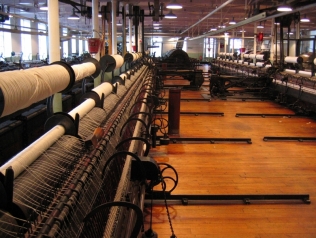Aerospace
Automotive
Chemical
Consumer Goods
Energy
Environmental Technology
Financial Services
Logistics & Transportation
Machinery & Equipment
Media & Entertainment
Medical Technology
Pharmaceuticals & Biotech
Professional Services
Retail Trade
Semiconductors
Software & Information Technology Services
Textiles
Travel, Tourism & Hospitality
Events

The U.S. textile industry is one of the more important employers in the manufacturing sector, with 232,000 workers, representing 2 percent of the U.S. manufacturing workforce. The United States is a globally competitive manufacturer of textiles, including textile raw materials, yarns, fabrics, apparel and home furnishings, and other textile finished products. Our strength is in cotton, manmade fibers, and a wide variety of yarns and fabrics, including those for apparel and industrial end-uses.
Textile industry workers are highly skilled and the industry is technologically advanced, with investments of $1.6 billion in total capital expenditures in 2013. In recent years, U.S. textile companies have focused on retooling their businesses, finding more effective work processes, investing in niche products and markets, and controlling costs.
The industry is globally competitive, ranking fourth in global export value behind China, India, and Germany. U.S. exports of textiles increased by 45 percent between 2009 and 2014, to $18.3 billion. More than 65 percent of U.S. textile exports go to our free trade agreement partner countries.
Industry Subsectors
Non-wovens: The end use markets for non-wovens are classified as either disposable or durables. The disposable end use markets are made up of product categories such as absorbent hygiene, wipes, filtration, medical and surgical and protective apparel, while the durable end use markets are comprised of geosynthetics, home and office furnishings, transportation, building construction and other durables. Nonwovens are being used to make products lighter, more efficient, and cost effective. More and more of these lighter and longerlasting non-wovens are being introduced in a variety of fields including packaging and autos.
Specialty and Industrial Fabrics: Specialty and industrial fabrics serve an array of markets, everything from awnings to auto airbags. As the U.S. specialty fabric business has continued to grow, some areas are seeing rapid advancement, for example, the base fabric used in road construction, erosion control, and spoil containment in landfills. Automotive textiles represent the most valuable world market for industrial textiles. These materials cover a broad range of applications, including upholstery and seating, floor covering and trunk liners, as well as safety belts, airbags, thermal and sound insulators, filters, hoses, tires and a variety of textile-reinforced flexible and hard composites.
Medical Textiles: Medical textiles are one of the most important, continuously expanding and growing fields in technical textiles. The medical textile industry has been improving existing products and creating new ones with new materials and innovative designs. Some of these new products are being designed for lessinvasive surgical procedures, infection control, and accelerated healing.
Protective Apparel: North America emerged as the leading regional market for industrial protective apparel and accounted for over half of the total market volume in 2013. Stringent regulatory guidelines coupled with high levels of safety awareness in the industry are expected to drive the regional market growth over the next six years.
Analysis provided by the International Trade Association’s Office of Textiles and Apparel.
Federal Resources
Revolutionary Fibers and Textiles Manufacturing Innovation Institute: On March 18, 2015, the President announced that $75 million from the Department of Defense has committed to an Institute for Manufacturing Innovation competition in Revolutionary Fibers and Textiles. The Department is launching a competition for leading manufacturers, universities, and non-profits to form a new manufacturing hub focused on revolutionary fibers and textiles technologies. This public-private partnership is expected to generate at least 1:1 cost-share from industry, bringing more than $150 million in public and private investment funds. The Revolutionary Fibers and Textiles Manufacturing Innovation Institute (RFT-MII) will ensure that America leads in the manufacturing of new products from leading edge innovations in fiber science, commercializing fibers and textiles with extraordinary properties.
Industry Associations:
Industrial Fabrics Association International (IFAI)
INDA, Association of the Nonwoven Fabrics Industry
National Council of Textile Organizations (NCTO)
U.S. Industrial Fabrics Institute (USIFI)
Industry Publications:
Fabrics and Furnishings International
Home Furnishings News (HFN)
LDB Interior Textiles
Nonwovens Industry Magazine
Specialty Fabrics Review
Textile World
Tweets from https://twitter.com/SelectUSA/lists/textiles-news